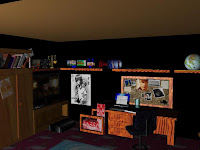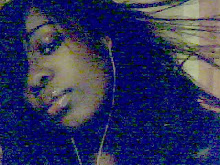Monday, 6 December 2010
Tuesday, 1 June 2010
Lights


The globe scene problems
-Also when the globe ball is in the air an when it rolls on the shelf, you can see that the rolling on the shelf is way too fast compared to when the all hits the floor,it doesn't look like it's a contination of the same action.
The same scene (3 angles view)
Train-lamp-globe-frames-small transparent ball
Small ball to clock
Anticipation
Problems I encoutered
Jerking camera test
-I had a problem with understanding how to use the difference tool. I tried to make a hole in a rectangle to create a box but it always ended creating a smaller rectangle. Then I realize that I had to select the biggest shape then the smallest one in order to make a hole the shape of the smaller selected shape in the biggest selected shape.
-Making the globe roll was another issue, it simply wouldn't roll properly because I rotated the object myself every 10 frames but I did not rotate it the right way, so the whole rotation looked funny. Then I remember what we were told about maya creating the frames in-between, so I decided to save a keyframe where the globe hasnt started rotating on the shelf yet, then I moved the globe to the bottom and rotated all the way round until the image of globe reached the same point as the one on the first keyframe...and it worked it rotated properly maybe too fast because there weren't many keyframes but it looked smooth.
-Textures: I had a problem with placing textures on my shapes, they stretched all over the place, so I hadto learn how to use plannar mapping in order to place the texture exactely where I wanted it to be (I also found that, I could select a face and apply a texture to it instead of the whole object, which I did to my train)
-I did not use the graph to create curves for my bouncing ball but I intend to do so the next time
Friday, 28 May 2010
Camera angles



Screenshots (Maya Modelling)
 Modelling a vase in maya
Modelling a vase in maya Modelling a wooden statue
Modelling a wooden statue

Thursday, 27 May 2010
Extrude, difference, union (Planning Modelling)



List of websites tutorials I used
Some tests of my own
(I had to replace the train with a small car and the lamp with a deorodant stick because the lamp is too big for the car and in my animation the train is heavier than the lamp).
Just trying to see how I could make my books and DVDs fall in the video
Animatic
Domino Effect- Reference videos
Building shapes in Illustrator
.jpg)
.jpg)
Some objects with different views
.jpg)
.jpg)
See Illustrator shapes on CD for more objects with different views#
Illustrator- Sequence of events
Here is the image that shows the sequence of events (The final piece)
 (It has also been sved into an AI file- See CD)
(It has also been sved into an AI file- See CD)Print or Web ?
.jpg)
Colour mode: RGB Resolution: 72 DPI File Format: Either JPEG, GIF or PNG
PRINTING-Could be saved as TIFF or EPS
.jpg) Colour mode: CMYK Resolution: 300DPI FILE FORMAT: EPS or TIFF
Colour mode: CMYK Resolution: 300DPI FILE FORMAT: EPS or TIFFObjects references (From my Bedroom)
+1.jpg)
.jpg) And some objects references found on the internet (Objects that I couldn't find or didn't have).
And some objects references found on the internet (Objects that I couldn't find or didn't have).

How I came up with my montage
+real.jpg)
To select the different objects I just had to combine the select marquee tool, ellipse tool, magic want, quick mask mode, magnetic and polygonal tool.
MONTAGE PART 2 - Selection tools with FLIP, RE-SCALE and Rotate
+real.jpg)
Bedroom References


My Final Floor Plan

.jpg)
Monday, 3 May 2010
Friday, 30 April 2010
Floor Plan- Sample 2
Blue prints-Floor plan

Domino effect- Kitchen Theme
-Microwave -Plates -Milk
-Sink -Glasses -Sugar
-Fridge -Knives,forks,spoons -Salt
-Freezer -Coffee machine -Food (Eggs...)
-Mugs -Pots
-Frying pans -Bowls
-Washing machine -Cereals
-Dish washer -Fruits
Thursday, 29 April 2010
1st Mini task achieved- =)

The wooden table.
Croissants and Forks
 For the two croissants I simply used the magnetic tool since teh edgs are roun and soft enough, and the background is light and plain, it doesn't get mixed with the croissant.
For the two croissants I simply used the magnetic tool since teh edgs are roun and soft enough, and the background is light and plain, it doesn't get mixed with the croissant. ♥ For the second croissant, the one under the croissant on top, I simply rotated it and added a distort effect to it to make it look somehow flatter (To make it look like it's really on the plate).
FORKS
 To select the knife I first used the magnetic tool, then after pasting it on the montage, I looked very closely and realized that it ad somehow selected the white edges as well, so I tried to clean the white edges using the eraser tool, it didn't come out as expected, it gave the knife edges a wobbly look.
To select the knife I first used the magnetic tool, then after pasting it on the montage, I looked very closely and realized that it ad somehow selected the white edges as well, so I tried to clean the white edges using the eraser tool, it didn't come out as expected, it gave the knife edges a wobbly look.My resort was to use the polygonal tool to selected the white and wobbly edges ando delete them.
Same procedure was foolowed for the fork. (This time around I didn't use the magnetic tool but only the polygonal lasso tool, the edges wheretoo sharp to use the magnetic tool).









+real.jpg)







